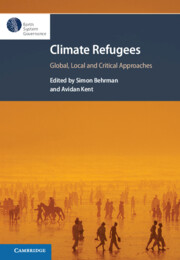Book contents
- Climate Refugees
- Series page
- Climate Refugees
- Copyright page
- Contents
- Contributors
- Acknowledgements
- 1 An Alternative Introduction: An Interview with the Editors, Which Never Took Place
- Part I Global Governance
- Part II International Law
- 5 Lessons from the Past Momentum Going Forward: Norm Dynamics and the Process of Protection for Climate-Induced Migration and Displacement
- 6 Collective Action, Common Concern, and Climate-Induced Migration
- 7 Migrating with Dignity
- 8 Climate Displacement and the Right to Mental Health
- Part III Regional and Local Perspectives and Solutions
- Part IV Critical Approaches
- Index
7 - Migrating with Dignity
Protecting the Rights of ‘Climate Refugees’ with the Non-refoulement Principle
from Part II - International Law
Published online by Cambridge University Press: 01 April 2022
- Climate Refugees
- Series page
- Climate Refugees
- Copyright page
- Contents
- Contributors
- Acknowledgements
- 1 An Alternative Introduction: An Interview with the Editors, Which Never Took Place
- Part I Global Governance
- Part II International Law
- 5 Lessons from the Past Momentum Going Forward: Norm Dynamics and the Process of Protection for Climate-Induced Migration and Displacement
- 6 Collective Action, Common Concern, and Climate-Induced Migration
- 7 Migrating with Dignity
- 8 Climate Displacement and the Right to Mental Health
- Part III Regional and Local Perspectives and Solutions
- Part IV Critical Approaches
- Index
Summary
Much ink has been spilled by scholars,1 including the present author,2 on displacement associated with climate change, popularly called ‘climate refugees’, recognising the need to address the protection gap relating to them. Despite the recognition in the very first report of the Intergovernmental Panel on Climate Change (IPCC) that climate change could cause forced displacement of millions of people,3 climate negotiators have been slow (and reluctant) to address the issue.
- Type
- Chapter
- Information
- Climate RefugeesGlobal, Local and Critical Approaches, pp. 127 - 145Publisher: Cambridge University PressPrint publication year: 2022
- 2
- Cited by

